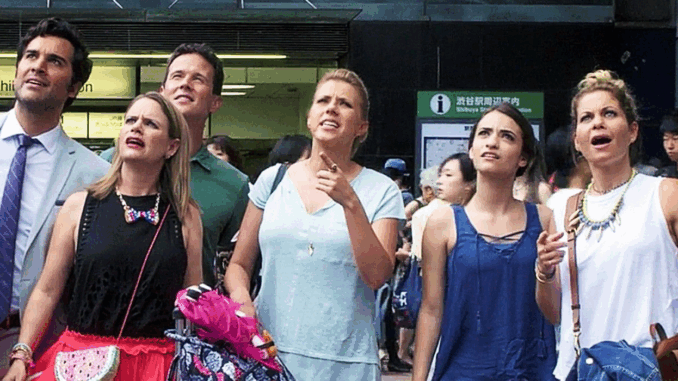
So you’ve heard Fuller House finally went international in Season 3—but did they actually film in Japan? Yes—and no. The buzz was real. Netflix flew the main cast to Tokyo to shoot key scenes for Steve and C.J.’s wedding arc, giving fans the rare treat of seeing the Tanners abroad. Let’s unpack where, why, and how that all happened—and what it meant for the series.
1. The Setup: Wedding in Tokyo
In Season 3’s storyline, Steve (Scott Weinger) and C.J. are set to marry in Japan. The Tanners head overseas to celebrate—and the show leaned into full vacation visuals. This wasn’t just green-screen—it was the real deal. Voice insider reports confirmed Netflix flew the ensemble overseas
2. Real Footage: Hello Kitty, Shibuya, and More
The episode titled “My Best Friend’s Japanese Wedding” features the family exploring major Tokyo landmarks, including Sanrio Puroland (Hello Kitty Land) and the famous Shibuya Crossing. Those vibrant visuals? Genuine footage shot on location in Japan
3. Did the Cast Actually Go There?
Yes! Candace Cameron Bure confirmed the cast and crew were physically present in Tokyo. She shared behind-the-scenes content on social media during filming in 2017. It wasn’t just set dressing—it was a true international shoot
4. Domestic vs. Japan Filming Locations
While Tokyo scenes were shot on location, the bulk of Fuller House continued in Los Angeles. Studio filming took place on Stage 24 at Warner Bros. Burbank, while San Francisco establishing shots came from the original Tanner house and recognizable landmarks
5. Why Take It Overseas? Netflix’s High-Stakes Move
Netflix aimed to revitalize the nostalgia of Full House while boosting global production value. Season 3’s Japan arc represented ambition—the first time the Tanners left California on camera. The payoff? Big visual appeal and boosted hook for international audiences
6. Some Fans Missed the Mark
Not everyone loved the Japan trip. Redditors complained the arc dragged on, and some viewers exited the series after that storyline, calling it fan-service gone wrong. Still, most agreed the visuals were impressive—even if the writing felt weak
7. On-Screen vs. Studio: A Technical Comparison
Studio work emulated the Tanner set inside, with the Tokyo scenes standing in bold contrast. Scripts incorporated excursions to Japanese landmarks—something you don’t get from soundstage footage—and allowed for a real location shoot in an otherwise studio-heavy show
8. The Legend of the ‘Dragon’
One curious subplot in the Japan episode: CJ introduces Steve to her stepfather, known as “The Dragon,” hinting at ties to Japanese organized crime. Fans debated whether this storyline made sense off-set—and questioned the cultural accuracy—adding to the controversy around the arc
9. How Many Episodes Were Set in Japan?
Only a single multi-part arc spanned the wedding in Tokyo—covering those standout episodes. The rest of the season stayed Stateside, focusing on domestic plotlines and home life recovery after the trip
10. Industry First for the Franchise
Neither Full House nor Fuller House had previously filmed overseas. Even the original’s trips to Hawaii or Disney World were set in the U.S. Japan marked a first—propelling the reboot beyond nostalgic set pieces into action-based travel storytelling
11. Behind the Camera: Logistics of a Japan Shoot
Taking an entire cast and crew overseas is no small feat. It involved travel coordination, location permits, cultural liaison, and production security. Fans got rare glimpses of cityscapes and nightlife… hints that the money and coordination were real
12. How It Compares to Original Full House Trips
In the original Full House, vacations stayed U.S.-focused—Disney World and Hawaii were the farthest destinations. Japan broadened the scope visually and narratively, aligning Fuller House with modern streaming expectations
13. Cast Impressions from Tokyo
Candace Cameron Bure called the adventure “even bigger” than previous nostalgia callbacks. Though not all original cast members attended—John Stamos, Lori Loughlin, etc., were absent—most of the core cast made the trip
14. What Fans Said Later in 2025
Reddit commentary indicates mixed reception:
“Everyone flew to Japan for essentially nothing… so dumb.”
“It felt very frustrating—they ended DJ and Steve arc weird.”
Still, many acknowledged the effort behind filming abroad—even if the storyline disappointed
15. Legacy: Did Filming in Japan Impact the Show’s Reputation?
Fuller House ended after five seasons. Critics often cited nostalgia overload and weak arcs—not logistics—as cancellation reasons. The Japan episode stands out as bold—but polarizing. Production dared to go global; writing didn’t always follow through
Conclusion
In short: Yes, Fuller House Season 3 did film in Japan. Netflix flew the cast to Tokyo for a wedding extravaganza, capturing real footage in major landmarks like Hello Kitty Land and Shibuya Crossing. But don’t expect all episodes to be Japan-based—most were filmed entirely in Los Angeles. The trip marked a first for the franchise and offered high visual payoff, though not without fan controversy. It was ambition meeting nostalgia—sometimes thrilling, often divisive.
FAQs
1. Did the cast of Fuller House really travel to Japan?
Absolutely—Netflix flew the main cast to Tokyo to shoot the wedding arc in Season 3, with real footage of landmarks like Sanrio Puroland and Shibuya Crossing
2. Was the Tokyo episode filmed on set or on location?
Japan scenes were filmed on location in Tokyo. Other scenes continued at Warner Bros. in Burbank and on the built replica Tanner house set
3. Which Tokyo landmarks appear in the episode?
The cast visits Hello Kitty Land (Sanrio Puroland) and is shown crossing Shibuya Crossing during sightseeing scenes
4. How many episodes are set in Japan?
A multi-episode arc in Season 3 covers the Tokyo wedding storyline. The remaining episodes are filmed back in California
5. Did the Japan storyline affect the show’s reception?
Yes—in mixed ways. Some viewers praised the ambition; others criticized the arc as distraction or fan-service. It didn’t drive cancellation, but it remains a polarizing moment
